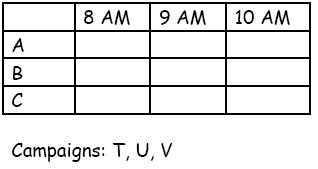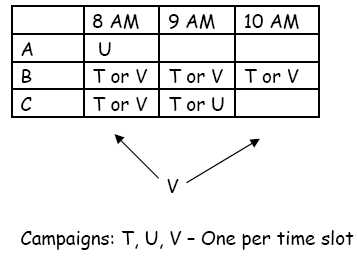LSAT Matching Sketches
Matching is a common game type on the LSAT test. Let’s take a look at the game setup we saw in the previous article and see how we might form a sketch.
This is the second article in a series of articles about LSAT Matching Games. The series includes:
- LSAT Matching Games: an introduction
- LSAT Matching Sketches
- Matching Game Questions
LSAT Matching Sketches
Here is the setup of our game once more as a reminder:
Three advertising agencies – A-Plus, Brenner Designs and Coverdale, Inc. – are making proposals for three different types of marketing campaigns to the same client. Each agency will present only one type of campaign during each presentation – Targeted, Universal and Vertical. Each company will be given an opportunity to present at 8 AM, 9 AM and 10 AM and may propose the same campaign more than once, but only one campaign per time slot. The following is known about the agencies and their campaigns:
Brenner does not present a Universal campaign in any of their presentations.
Coverdale presents a Vertical campaign in at least on of their three presentations, but not at 9 AM
A-Plus presents the same campaign at 9 AM and at 10 AM
Coverdale does not present a Universal campaign at 8 AM
No agency presents the same campaign in the same time slot
Since you know the game is a matching game (meaning that you can use the attributes, or campaign types, more than once), start by drawing your grid. Attributes (the variables that can change) go in the middle, entities (the things that don’t change) go on the outside.
Here’s another tip: what if you were a secretary scheduling these presentations on a calendar – what would that look like?

Note we’ve shortened the agency and campaign names to save time – why write “Coverdale,” over and over again in your sketches?
Paraphrase the Matching Rules
Now that you have your sketch ready, make a paraphrase of the rules. The best rules are the ones you can add directly to your sketch, but if you can’t do that, at least make a paraphrase that you can instantly recognize rather than rereading the stimulus.
Here are the rules again with suggestions for how to think them through and paraphrase them on your sketch:
Brenner does not present a Universal campaign in any of their presentations.
Paraphrase: Try to take any negative rule and come up with something positive and concrete you can add to your sketch. If Brenner does not present Universal in any time slot, then write what they can present (T or V) in each of their boxes.
Coverdale presents a Vertical campaign in at least on of their three presentations, but not at 9 AM
Paraphrase: This is a sneaky way of giving you two rules, but making it look like one. Deal with it as two separate rules. First, write some sort of reminder that Coverdale has to use V at either 8 or 10 (or both). Second, write “T or U” in their 9 AM slot.
A-Plus presents the same campaign at 9 AM and at 10 AM
Paraphrase: Simply draw an arrow between A-Plus’s 9 and 10 boxes.
Coverdale does not present a Universal campaign at 8 AM
Paraphrase: Turn this into a positive concrete rule on your sketch – write “T or V” in Coverdale’s 8 AM box.
No agency presents the same campaign in the same time slot
Paraphrase: We’ll make some deductions out of this later, but this is basically a loophole closer – once a campaign is presented by someone during a time slot, it can’t be presented again. You might add a note to this effect on your sketch.
Your sketch should now look something like this:

Make Deductions
Now it’s time to get the extra bonus points out of the game. There’s really only one big deduction to make here, but as always it’s worth it. Brenner and Coverdale have to choose between the T or V campaigns at 8 AM. That only leaves U for A-Plus in the 8 AM slot.
Adding U to A/8AM, our sketch should now look like this:

Now let’s look at the entire game as we attack Matching Game Questions.
